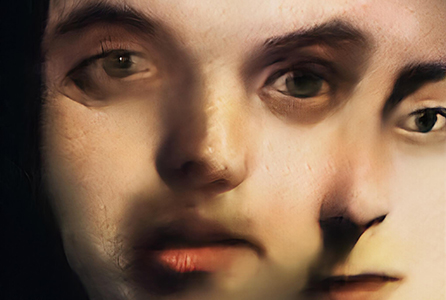AI and digital screens infiltrate art
Sotheby’s, a broker of fine and decorative art, jewellery, real estate and collectables, is set to sell AI-inspired art that utilises digital screens as art in a rumoured £40,000 sale.

Monday, 11 Feb 2019 10:48 GMT

The digital screens are made to look like they are powered by the AI ‘brain’ that is located inside the wooden console
The aptly-named ‘Memories of Passersby 1’ consists of two digital screens, which are framed and attached to a wooden table or ‘console’ that is acting as the ‘brain’ of the artificial intelligence.
The art is particularly interesting because it displays a picture whilst the viewer is looking at it – the portraits are rather uncomfortable paintings of a male and female. It is also unique because these figures then disappear and are not seen by anyone else ever again; the images are conjured up while the viewer is stood there observing the screens.
The artwork was created by German artist Mario Klingemann, who utilises his abilities in coding, neutral networks and algorithms to create his statements. He writes on his website that he has a “sceptic and curious mind”. He also says that “my interests are manifold and in constant evolution, involving artificial intelligence, deep learning, generative and evolutionary art, glitch art, data classification and visualisation or robotic installations”.

AI art is the latest innovation winning its place in art history books, and Klingemann’s work stands on the precipice of an exciting new era in our field”
The British-founded American broker Sotheby’s is set to auction the artwork for between £30,000 and £40,000. It will be showcased at the company’s Contemporary Art Day Auction in London on March 6th.
Klingemann says of his artwork: “‘Memories of Passersby 1’ houses a very powerful machine which creates paintings while you look at them, which I think is quite magical. Neutral networks are involved, and you could say that they are the brushes that I’ve learned to use. The machine is in a cycle where it continuously creates new faces that start changing and fading away – it observes itself and creates a feedback loop.
“Of course, it’s hard for me to let it out into the world without me by its side, but I trust that it’s ready to keep creating new portraits forever, as I always hope it would do. I hope that when people sit and watch these fleeting faces pass by, they will get the same feeling I do.”

The screens display slightly-disturbing images of men and women while the viewer is observing
“In seeking to subvert more traditional processes of creation, Klingemann’s work presents a truly amazing opportunity to watch an AI brain think in real time, as a machine creates brand new portraits pixel by pixel,” says Marina Ruiz Colomer, contemporary art specialist and head of Sotheby’s Contemporary Art Day Auction.
She adds: “To offer a cutting-edge piece of technology such as this, which has the power to generate haunting portraits reminiscent of past masters, is truly unprecedented. It is the nature of contemporary art to push boundaries – boundaries which have been, and will continue to be, redefined for centuries.
“AI art is the latest innovation winning its place in art history books, and Klingemann’s work stands on the precipice of an exciting new era in our field.”
If you have an interesting story or a view on this news, then please e-mail
news@signlink.co.uk
Follow Genevieve on:
